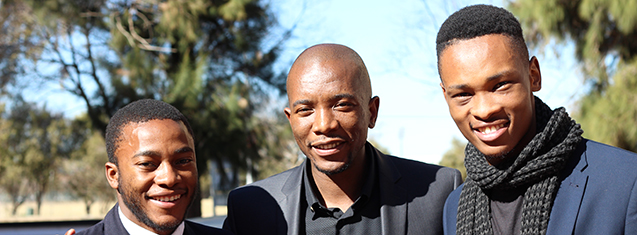
Mmusi Maimane, leader of the Democratic Alliance with co-organisers of TEDxUFS Bonginkosi Leeuw and Lerothodi Molete after his inspirational talk at the event.
Photo: Curtis Nhlamulo Mashimbye
This year’s TEDxUFS speaker lineup persuaded the audience unanimously to question the nature of reality. The Albert Wessels Auditorium on the Bloemfontein Campus was packed with about 200 attendees on Saturday 1 August 2015.
Speakers shared a multiplicity of profound theories and inquisitions, challenging society in general to think out of the box. Melody Mentz, Gil Oved, Ricardo Peach, Pamela Nomvete, Pepe Marais, Mmusi Maimane, Brian Kally, Pieter Geldenhuys, Philippa Tumubweinee, Gareth Cliff, and Angelo Mockie took on to the stage to tackle multidisciplinary concepts as part of the broad ‘Ask Why’ theme.
Innovation mouthpieces share their worldview
Pieter Geldenhuys, the internationally-renowned futurist and Director of the Institute for Technology Strategy, and Innovation proposed that we change our mindsets by neglecting predictability. “We need to look at different models to understand the world around us,” he said. He challenged the linear and familiar ways humans make sense of the universe.
Speaking to the dire need for transformation, Philippa Tumubweinee suggested that university spaces merge with the communities they serve in terms of policies, social atmosphere, and physical structure. Tumubweinee is a senior Lecturer at the Department of Architecture at our university, and co-Founder and Director of Izuba In Africa architects.
“Only we can give permission to be intimidated; so don’t give in,” said Brian Kally, the CEO of Arrow Logistics (Pty) Ltd. Kally underscored the power of believing in our individual ideas.
Guidelines from TEDxUFS organisers
Bonginkosi Leeuw: “If you take your brainchild and implement it, and make it a reality, that’s when you can achieve great things, not before that.”
Lerothodi Molete: “You should ask questions; the moment you ask the question you will understand more.”
Real-time social media feedback
These are some of the comments audience members published on Twitter at the event:
IG: mispertanzy ?@MiesperTanzy Aug 1
A huge shout-out to @TEDxUFS for hosting such a great conference!The team has really made the event an unmissable one on the UFS calendar.
Celebrabitur? ?@HatsuMphatsoe Aug 1
Proximity that allows us to experience our broader society. Truly engaged by Philippa Tumbweinee's talk! @TEDxUFS
TEDxJohannesburg ?@TEDxJoburg Aug 1
A big shoutout to @TEDxUFS from for a fantastic event. Wish we were there.
RicardoPeach ?@ricardopeach Aug 1
Africa is rich with potential #TEDXUFS @MmusiMaimane Yes!